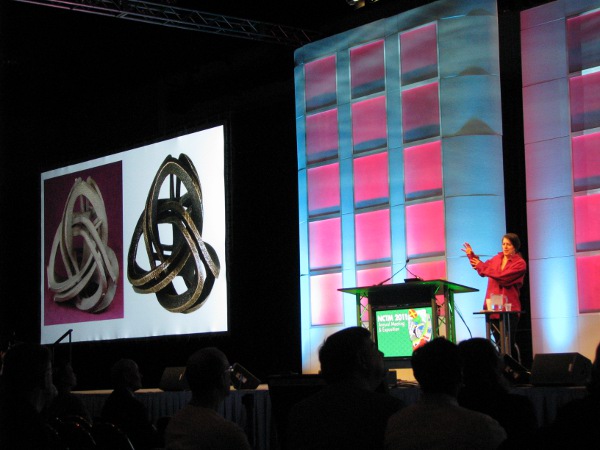By Tech Powered Dad | April 17, 2011
The 2011 NCTM annual meeting is over, and I have arrived back home in Illinois. Sorry it took me a while to get this post up, but the return trip took most of Saturday. Indianapolis was a great choice for the convention. It’s so easy to move around downtown via their system of skybridges that allow you to walk for blocks at a time without ever being exposed to bad weather. Here’s my convention wrapup.
iPad Math Textbooks

Taking the new graphing calculators out of the mix, maybe the coolest thing I saw at NCTM this weas Holt McDougal’s series of new Ipad math textbooks. Holt McDougal (a division of Houghton Mifflin Harcourt) rep Gary Belman gave me a tour of their Algebra I iPad textbook. Belman says the iPad math books are designed to completely replace traditional textbooks but offer a much richer experience. At first glance, the book looks exactly like their traditional textbook, page for page. But as you start to explore, you realize there are icons to be tapped that can bring up additional information, including videos of teachers explaining the problems step by step. There are also note taking abilities, a simple built in graphing calculator, and more.
This technology could be a whole article in and of itself, and I hope to write one in the future. They quick look I got was very impressive, and I am excited to see where this technology goes. While it’s designed as a textbook replacement for schools ($49.99 for a 6-year license), you can also see how parents might purchase it as a textbook supplement and why homeschoolers would be interested. Belman said they plan to adapt to other platforms such as Android as tablet technology develops. I say kudos to an education company for leading the way on a new technology rather than waiting to see what comes out of other industries first and then playing catchup.
Quick Looks at the Exhibit Floor
- Take a look at FluidMath by Fluidity Software. This dynamic algebra software has the capability to makes graphing equations more understandable than any calculator or other software I’ve seen. It does require an Interactive Whiteboard (like Smartboard) or a Tablet PC.
- I’d never heard of Mathathon, but they had representatives in attendance, and what a great way to help the kids of St. Jude hospital. I live just outside of Peoria, IL, where the sister hospital to St. Jude’s big campus in Memphis is located, and I can tell you it’s an amazing mission. If you are a parent or teacher of K-8 students, please consider getting involved.
- Never have I seen more enthusiastic reps at a show like this than the folks of Mimio. Mimio is a low(er) cost alternative to Smartboards, allowing teachers to hook up a “capture bar” to any white board rather than have to purchase a full Smartboard. By the end of the presentation I watched, they had the crowd chanting “Mimio! Mimio!”
Web 2.0 in the Classroom
After leaving the exhibit hall for the final time, I went to Leigh Nataro’s presentation on Web 2.0 in the classroom. While she touched on a number of Web 2.0 properties from Twitter to Youtube, her focus was on Facebook. Nataro set up a closed group on Facebook that allowed her to ask questions of students that they could answer online. I like the idea a lot, although I’d probably use it to do something more along the lines of “virtual office hours.” Nataro was quick to point out that you don’t need to be Facebook friends with students to use a group, and she strongly suggested you don’t “friend” students, keeping you completely out of their personal information and keeping them out of yours.
3D Geometric Art

The closing session for the conference was really something. Bathsheba Grossman is a geometric artist, specifically a 3d geometric artist. There’s nothing I can say that will do justice to the beauty of her work, so if you want to see it, I strongly suggest you check out her site, www.bathsheba.com. She described her transformation from college math student to geometric artist, a journey that began with an angle grinder and blocks of metal but has progressed to 3D printing. 3D printing (on Wikipedia) is a process whereby computer generated images are brought to life via lasers, metal dust, and plastic sheets. Grossman’s creative process is pretty amazing, a combination of high level mathematics, computer languages, and her mind’s eye. She also kept the crowd entertained throughout with her frank sense of humor.
That’s it for NCTM daily coverage. However, there are a few more tidbits I’ll trickle out over the next couple of weeks, so stay tuned.

